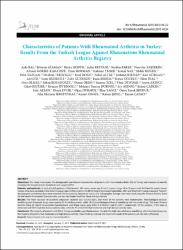| dc.contributor.author | Bal, Ajda | |
| dc.contributor.author | Ataman, Şebnem | |
| dc.contributor.author | Bodur, Hatice | |
| dc.contributor.author | Rezvani, Aylin | |
| dc.contributor.author | Paker, Nurdan | |
| dc.contributor.author | Taştekin, Nurettin | |
| dc.contributor.author | Göksel, Altınay Karatepe | |
| dc.contributor.author | Borman, Pınar | |
| dc.contributor.author | Yener, Mahmut | |
| dc.contributor.author | Nas, Kemal | |
| dc.contributor.author | Sezgin, Melek | |
| dc.contributor.author | Yazgan, Pelin | |
| dc.contributor.author | Tekeoğlu, İbrahim | |
| dc.contributor.author | Doğu, Beril | |
| dc.contributor.author | Altay, Zuhal | |
| dc.contributor.author | Kırnap, Mehmet | |
| dc.contributor.author | Gürgan, Alev | |
| dc.contributor.author | Gür, Ali | |
| dc.contributor.author | Hizmetli, Sami | |
| dc.contributor.author | Günendi, Zafer | |
| dc.contributor.author | Erdem, Rana | |
| dc.contributor.author | Uğurlu, Hatice | |
| dc.contributor.author | İnal, Elem | |
| dc.contributor.author | Ölmez, Neşe | |
| dc.contributor.author | Kozanoğlu, Erkan | |
| dc.contributor.author | Öken, Öznur | |
| dc.contributor.author | Özel, Sumru | |
| dc.contributor.author | Dündar, Ümit | |
| dc.contributor.author | Akıncı, Ayşen | |
| dc.contributor.author | Öztürk, Cihat | |
| dc.contributor.author | Çapacı, Kazım | |
| dc.contributor.author | Sivrioğlu, Konçuy | |
| dc.contributor.author | Altan, Lale | |
| dc.contributor.author | Duruöz, Mehmet Tuncay | |
| dc.contributor.author | Yağcı, İlker | |
| dc.contributor.author | Aydoğ, Ece | |
| dc.contributor.author | Çapkın, Erhan | |
| dc.contributor.author | Evcik, Deniz | |
| dc.contributor.author | Durmuş, Oğuz | |
| dc.contributor.author | Şendur, Ömer Faruk | |
| dc.contributor.author | Sertpoyraz, Filiz Meryem | |
| dc.contributor.author | Özgül, Ahmet | |
| dc.contributor.author | Şenal, Kazım | |
| dc.date.accessioned | 12.07.201910:49:13 | |
| dc.date.accessioned | 2019-07-11T21:55:28Z | |
| dc.date.available | 12.07.201910:49:13 | |
| dc.date.available | 2019-07-11T21:55:28Z | |
| dc.date.issued | 2015 | |
| dc.identifier.issn | 2148-5046 | |
| dc.identifier.uri | https://app.trdizin.gov.tr/makale/TVRZNE5qRXdNQT09 | |
| dc.identifier.uri | https://hdl.handle.net/20.500.12513/649 | |
| dc.description.abstract | Amaç: Bu çalışmanın amacı Türkiye’deki romatoid artrit hastalarının demografik ve klinik özelliklerini ortaya koyarak bu hastalar için oluşturulabilecek önlem, tedavi ve destek stratejilerine ışık tutmaktır. Hastalar ve yöntemler: Bu çalışma kapsamında Eylül 2007 - Mart 2011 tarihleri arasında Türkiye’nin farklı bölgelerindeki toplam 36 merkezden Türkiye Romatizma Araştırma ve Savaş Derneği (TRASD) kayıt sistemine kaydedilen 2.359 hasta (1.966 kadın, 393 erkek; ort. yaş 51.6±12.5 yıl; dağılım 18-75 yıl) değerlendirildi. Hastaların demografik ve klinik verileri kaydedildi. Hastalık aktivitesi, fonksiyonel durum ve radyografik hasar sırasıyla hastalık aktivite skoru 28, sağlık değerlendirme anketi ve van der Heijde modifiye Sharp puanlama yöntemi ile ölçüldü. Bulgular: Akademik eğitim süresi ortalama 5.2±3.8 yıldı ve hastaların %74.6’sı ev hanımıydı. Hastaların %91.0’ı biyolojik olmayan hastalık modifiye edici ilaçlar, %10.2’si biyolojik hastalık modifiye edici ilaçlar kullanıyordu. Ortalama hastalık aktivite skoru 28, sağlık değerlendirme anketi ve Sharp puanları sırasıyla, 4.0±1.4, 0.38±0.37 ve 31.2±57.1 idi. Hastaların %17.8’i remisyonda ve %14.1’i düşük hastalık aktivitesinde iken %42.7’si orta hastalık aktivitesinde ve %25.5’i yüksek hastalık aktivitesinde idi. Sonuç: Türkiye’de romatoid artrit hastalarının çoğunluğu orta yaşlı ev hanımlarıdır. Her ne kadar hastalık modifiye edici ilaç kullanımı yüksek oranda ise de hastaların büyük bölümü orta ve yüksek hastalık aktivite düzeyinde idi. Bu bulgular romatoid artritli hastaların tedavi gereksinimlerinin yeterli olarak karşılanmadığını düşündürmektedir. | en_US |
| dc.description.abstract | Objectives: This study investigates the demographic and clinical characteristics of patients with rheumatoid arthritis (RA) in Turkey, and attempts to identify strategies for the prevention, treatment, and support of RA. Patients and methods: A total of 2,359 patients (1,966 females, 393 males; mean age 51.6±12.5 years; range 18 to 75 years) with RA from 36 centers across Turkey, who were recorded in the Turkish League Against Rheumatism (TLAR) RA Registry between September 2007 and March 2011, were evaluated. Patients’demographic and clinical data were recorded. Disease activity, functional status, and radiographic damage were measured using the Disease Activity Score 28, the Health Assessment Questionnaire, and van der Heijde modified Sharp scoring method. Results: The mean duration of academic education received was 5.2±3.8 years, and 74.6% of the patients were homemakers. Non-biological disease modifying anti-rheumatic drugs were used by 91.0% of the patients, while 10.2% used biological disease-modifying anti-rheumatic drugs. The mean Disease Activity Score 28, Health Assessment Questionnaire, and Sharp scores were 4.0±1.4, 0.38±0.37, and 31.2±57.1, respectively. Of the patients, 17.8% were in remission and 14.1% had low disease activity rates, while 42.7% and 25.5% had moderate and high disease activity rates. Conclusion: The majority of patients with RA in Turkey are middle-aged homemakers. Despite the high rates of disease-modifying anti-rheumatic drugs use, the majority of patients had moderate and high disease activity. These findings indicate that treatment needs of RA patients are not met sufficiently. | en_US |
| dc.language.iso | eng | en_US |
| dc.rights | info:eu-repo/semantics/openAccess | en_US |
| dc.subject | Romatoloji | en_US |
| dc.title | Characteristics of patients with rheumatoid arthritis in Turkey: Results from the turkish league against rheumatism rheumatoid arthritis registry | en_US |
| dc.title.alternative | Türkiye'deki romatoid artritli hastaların özellikleri: Türkiye romatizma araştırma ve savaş derneği romatoid artrit kayıt sistemi sonuçları | en_US |
| dc.type | article | en_US |
| dc.relation.journal | Archives of Rheumatology | en_US |
| dc.contributor.department | Kırşehir Ahi Evran Üniversitesi | en_US |
| dc.identifier.volume | 30 | en_US |
| dc.identifier.issue | 1 | en_US |
| dc.identifier.startpage | 16 | en_US |
| dc.identifier.endpage | 22 | en_US |
| dc.relation.publicationcategory | Makale - Ulusal Hakemli Dergi - Kurum Öğretim Elemanı | en_US] |


















